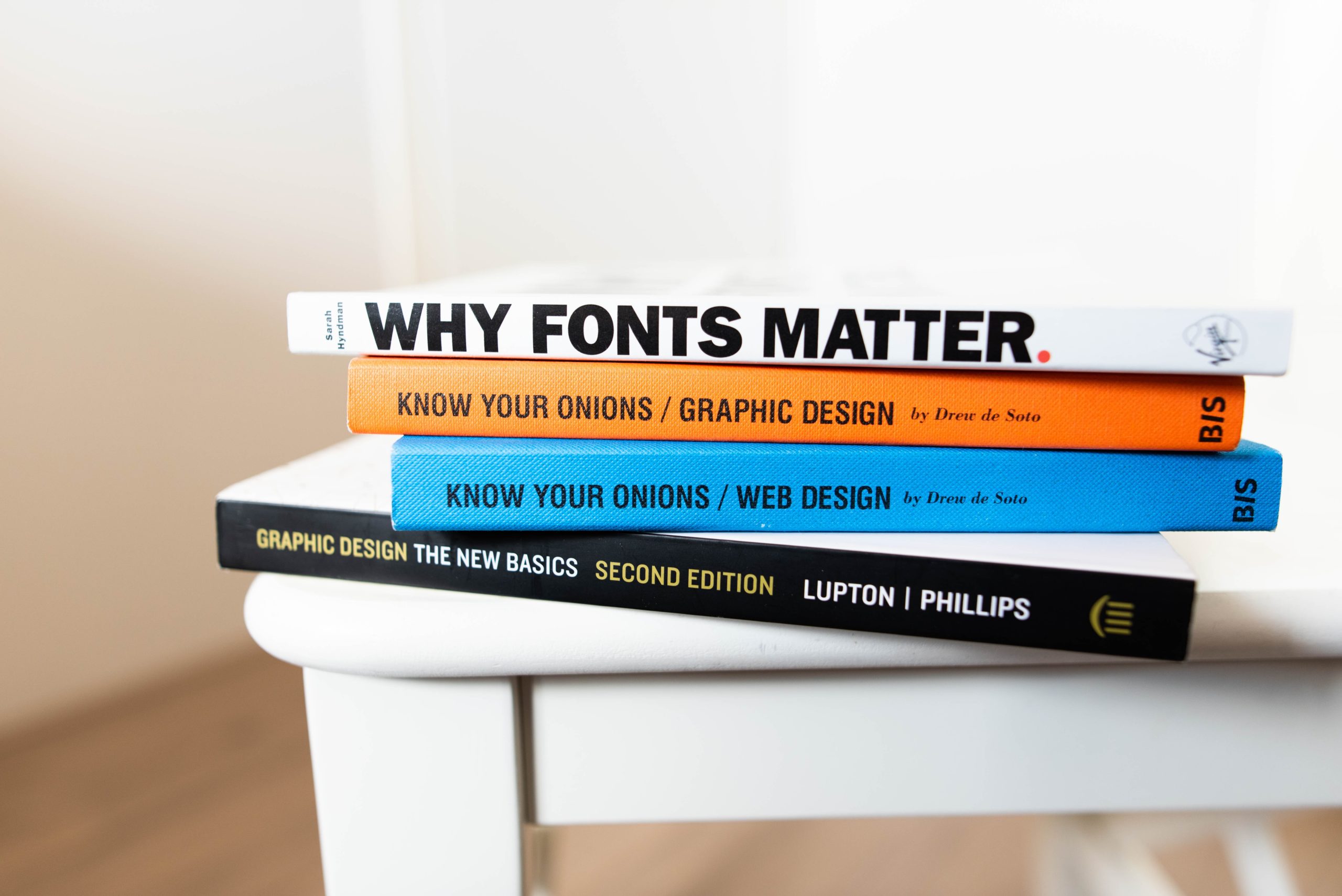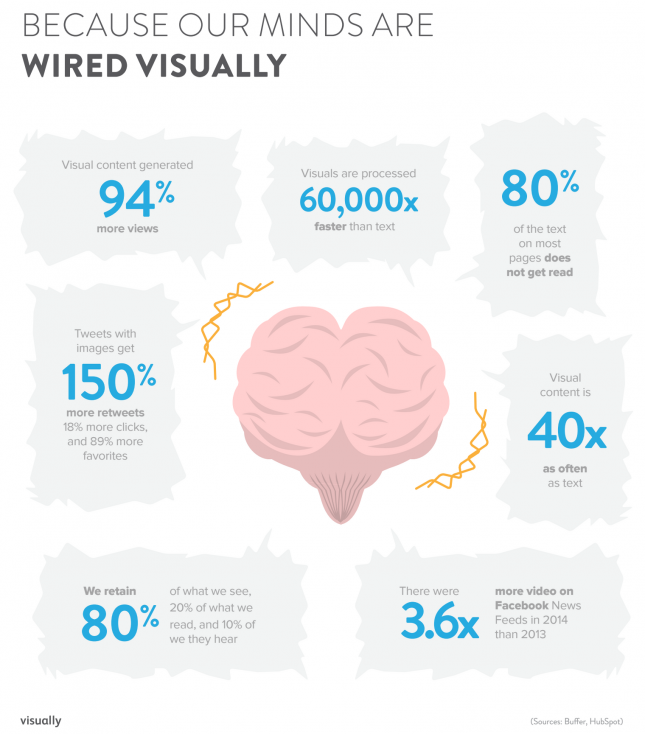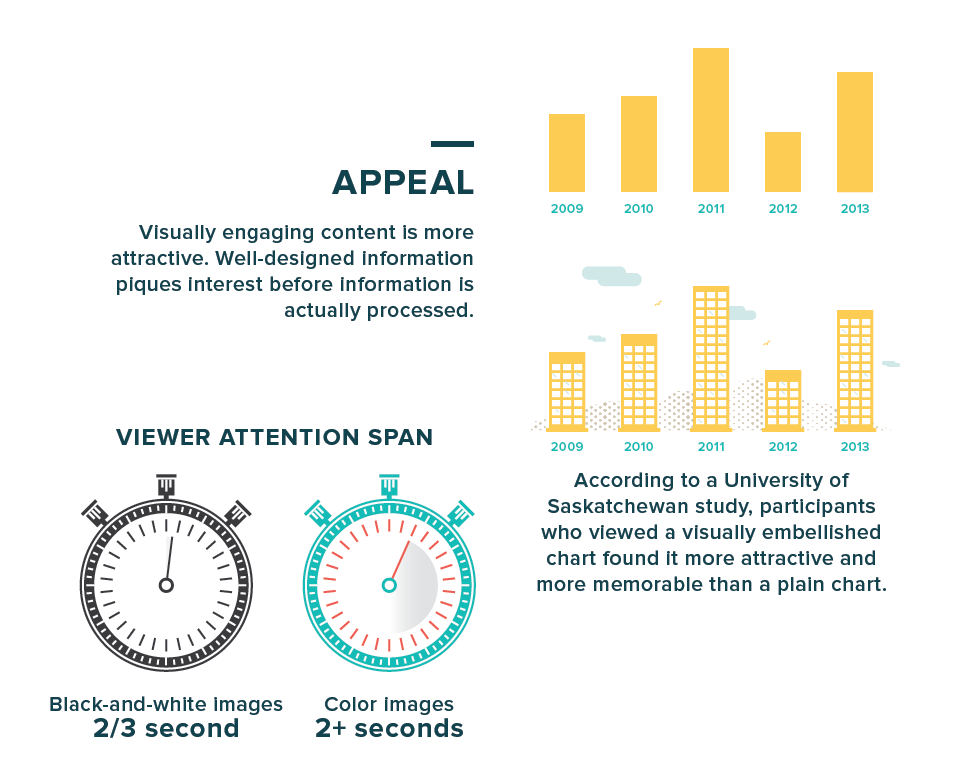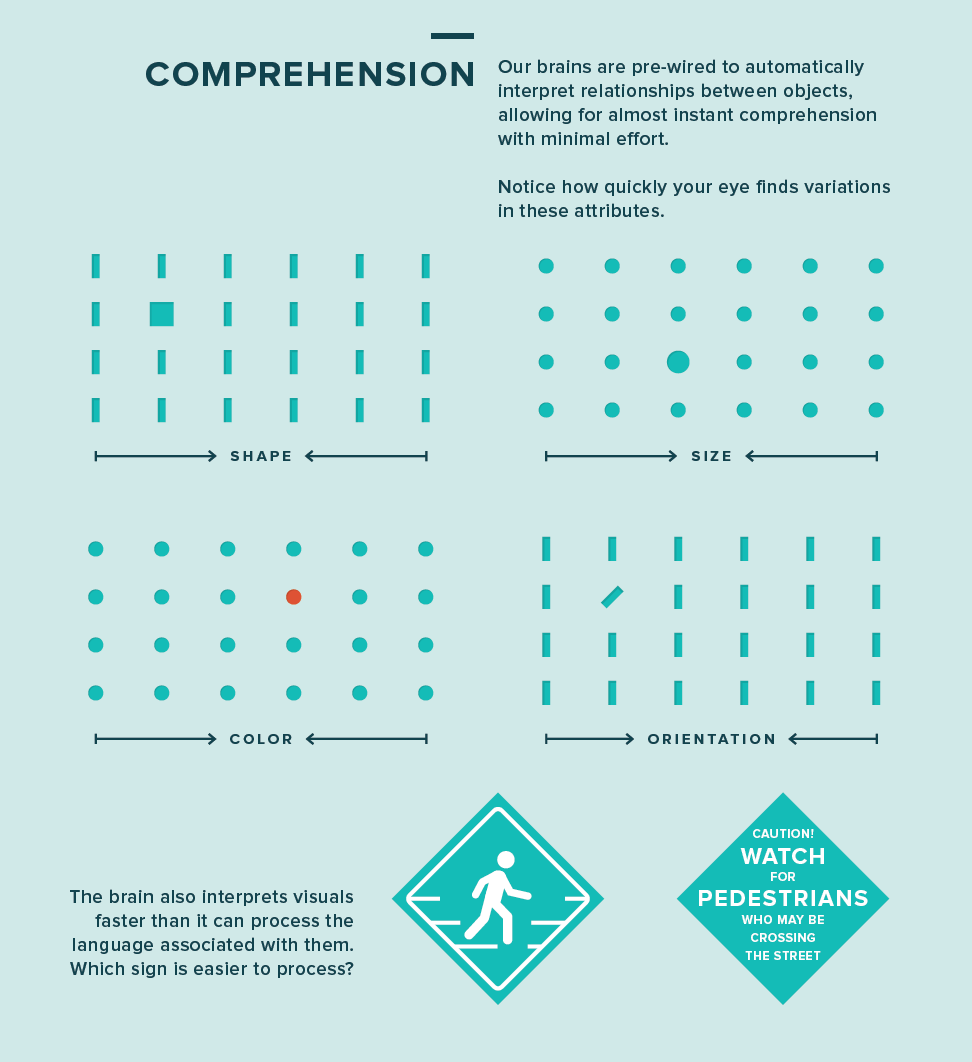Insights
What Creative Design Can Achieve for Organizations.

Oftentimes when organizations decide they need design work, they don’t really know why they need it. They just want someone to make their materials “look pretty” to connect their brand with new audiences, or make their paid, social, and owned channels more engaging. There is a general understanding that the human mind prefers visuals over text-heavy copy, but why? Why is graphic design so important, especially when trying to drive viewers to action?
Start With Psychology
 Image from “How Visual Content Affects Your Brain” by Rock Content
We consume around 100,500 words a day outside of work. In an age where we are constantly bombarded with information, people are left needing bite-sized pieces of information. As luck would have it, our brains are already set up this way! The average consumer has an attention span of about 8 seconds and it only takes a quarter of a second to process visual cues. This means that visuals can communicate your message instantly with minimal effort.
Giving Brains What They Want
When it comes to visuals, our brains crave them. 90% of the information we receive is visual—our brains process them 60,000x faster than text alone. In a Nieman Reports interview, Marcel Just, Director of the Center for Cognitive Brain Imaging at Carnegie Mellon said:
Processing print isn’t something the human brain was built for. The printed word is a human artifact. It’s very convenient and it’s worked very well for us for 5,000 years, but it’s an invention of human beings. By contrast Mother Nature has built into our brain our ability to see the visual world and interpret it. Even the spoken language is much more a given biologically than reading written language.
So how do you, as a communicator, use these powers for good? When coming up with materials for your organization, keep these valuable things in mind: appeal, comprehension, and retention.
Image from “How Visual Content Affects Your Brain” by Rock Content
We consume around 100,500 words a day outside of work. In an age where we are constantly bombarded with information, people are left needing bite-sized pieces of information. As luck would have it, our brains are already set up this way! The average consumer has an attention span of about 8 seconds and it only takes a quarter of a second to process visual cues. This means that visuals can communicate your message instantly with minimal effort.
Giving Brains What They Want
When it comes to visuals, our brains crave them. 90% of the information we receive is visual—our brains process them 60,000x faster than text alone. In a Nieman Reports interview, Marcel Just, Director of the Center for Cognitive Brain Imaging at Carnegie Mellon said:
Processing print isn’t something the human brain was built for. The printed word is a human artifact. It’s very convenient and it’s worked very well for us for 5,000 years, but it’s an invention of human beings. By contrast Mother Nature has built into our brain our ability to see the visual world and interpret it. Even the spoken language is much more a given biologically than reading written language.
So how do you, as a communicator, use these powers for good? When coming up with materials for your organization, keep these valuable things in mind: appeal, comprehension, and retention.
 Excerpt from Infographic “Why Our Brains Love Visual Content” by Column Five
What Graphic Design Can Achieve
When done well, visual content evokes emotion and makes content more appealing. Positive emotions toward an organization's campaigns are more influential than the actual content when it comes to a viewer’s intent to interact with a brand.
Excerpt from Infographic “Why Our Brains Love Visual Content” by Column Five
What Graphic Design Can Achieve
When done well, visual content evokes emotion and makes content more appealing. Positive emotions toward an organization's campaigns are more influential than the actual content when it comes to a viewer’s intent to interact with a brand.
 Excerpt from Infographic “Why Our Brains Love Visual Content” by Column Five
Excerpt from Infographic “Why Our Brains Love Visual Content” by Column Five
 Excerpt from Infographic “Why Our Brains Love Visual Content” by Column Five
People retain 80% of what they see, 20% of what they read, and 10% of what they hear: when you use graphics, your content is far more likely to stick in people’s brains.
Wrap-Up
Now that you have a better understanding of how our brains process information, it’s easier to see why visuals are so impactful when communicating with your audience. Some of the most impactful ad campaigns have included strong visuals with minimal copy. As you look to the rest of 2020 and begin planning for the years ahead, invest in graphics—they can make all the difference for your communications efforts.
Excerpt from Infographic “Why Our Brains Love Visual Content” by Column Five
People retain 80% of what they see, 20% of what they read, and 10% of what they hear: when you use graphics, your content is far more likely to stick in people’s brains.
Wrap-Up
Now that you have a better understanding of how our brains process information, it’s easier to see why visuals are so impactful when communicating with your audience. Some of the most impactful ad campaigns have included strong visuals with minimal copy. As you look to the rest of 2020 and begin planning for the years ahead, invest in graphics—they can make all the difference for your communications efforts.
 Image from “How Visual Content Affects Your Brain” by Rock Content
We consume around 100,500 words a day outside of work. In an age where we are constantly bombarded with information, people are left needing bite-sized pieces of information. As luck would have it, our brains are already set up this way! The average consumer has an attention span of about 8 seconds and it only takes a quarter of a second to process visual cues. This means that visuals can communicate your message instantly with minimal effort.
Giving Brains What They Want
When it comes to visuals, our brains crave them. 90% of the information we receive is visual—our brains process them 60,000x faster than text alone. In a Nieman Reports interview, Marcel Just, Director of the Center for Cognitive Brain Imaging at Carnegie Mellon said:
Processing print isn’t something the human brain was built for. The printed word is a human artifact. It’s very convenient and it’s worked very well for us for 5,000 years, but it’s an invention of human beings. By contrast Mother Nature has built into our brain our ability to see the visual world and interpret it. Even the spoken language is much more a given biologically than reading written language.
So how do you, as a communicator, use these powers for good? When coming up with materials for your organization, keep these valuable things in mind: appeal, comprehension, and retention.
Image from “How Visual Content Affects Your Brain” by Rock Content
We consume around 100,500 words a day outside of work. In an age where we are constantly bombarded with information, people are left needing bite-sized pieces of information. As luck would have it, our brains are already set up this way! The average consumer has an attention span of about 8 seconds and it only takes a quarter of a second to process visual cues. This means that visuals can communicate your message instantly with minimal effort.
Giving Brains What They Want
When it comes to visuals, our brains crave them. 90% of the information we receive is visual—our brains process them 60,000x faster than text alone. In a Nieman Reports interview, Marcel Just, Director of the Center for Cognitive Brain Imaging at Carnegie Mellon said:
Processing print isn’t something the human brain was built for. The printed word is a human artifact. It’s very convenient and it’s worked very well for us for 5,000 years, but it’s an invention of human beings. By contrast Mother Nature has built into our brain our ability to see the visual world and interpret it. Even the spoken language is much more a given biologically than reading written language.
So how do you, as a communicator, use these powers for good? When coming up with materials for your organization, keep these valuable things in mind: appeal, comprehension, and retention.
 Excerpt from Infographic “Why Our Brains Love Visual Content” by Column Five
What Graphic Design Can Achieve
When done well, visual content evokes emotion and makes content more appealing. Positive emotions toward an organization's campaigns are more influential than the actual content when it comes to a viewer’s intent to interact with a brand.
Excerpt from Infographic “Why Our Brains Love Visual Content” by Column Five
What Graphic Design Can Achieve
When done well, visual content evokes emotion and makes content more appealing. Positive emotions toward an organization's campaigns are more influential than the actual content when it comes to a viewer’s intent to interact with a brand.
 Excerpt from Infographic “Why Our Brains Love Visual Content” by Column Five
Excerpt from Infographic “Why Our Brains Love Visual Content” by Column Five
 Excerpt from Infographic “Why Our Brains Love Visual Content” by Column Five
People retain 80% of what they see, 20% of what they read, and 10% of what they hear: when you use graphics, your content is far more likely to stick in people’s brains.
Wrap-Up
Now that you have a better understanding of how our brains process information, it’s easier to see why visuals are so impactful when communicating with your audience. Some of the most impactful ad campaigns have included strong visuals with minimal copy. As you look to the rest of 2020 and begin planning for the years ahead, invest in graphics—they can make all the difference for your communications efforts.
Excerpt from Infographic “Why Our Brains Love Visual Content” by Column Five
People retain 80% of what they see, 20% of what they read, and 10% of what they hear: when you use graphics, your content is far more likely to stick in people’s brains.
Wrap-Up
Now that you have a better understanding of how our brains process information, it’s easier to see why visuals are so impactful when communicating with your audience. Some of the most impactful ad campaigns have included strong visuals with minimal copy. As you look to the rest of 2020 and begin planning for the years ahead, invest in graphics—they can make all the difference for your communications efforts.